
Aargau, more formally the Canton of Aargau, is one of the 26 cantons forming the Swiss Confederation. It is composed of eleven districts and its capital is Aarau.

The canton of Bern, or Berne, is one of the 26 cantons forming the Swiss Confederation. Its capital city, Bern, is also the de facto capital of Switzerland. The bear is the heraldic symbol of the canton, displayed on a red-yellow background.

Wurmsbach Abbey is a monastery of Cistercian nuns located in Bollingen, a locality of Rapperswil-Jona, in the Canton of St. Gallen, Switzerland. It is located on the north shore of upper Lake Zürich. The house is a part of the Order of Cistercians of the Common Observance (O.Cist.).

Brugg is a Swiss municipality and a town in the canton of Aargau and is the seat of the district of the same name. The town is located at the confluence of the Aare, Reuss, and Limmat, with the Aare flowing through its medieval part. It is located approximately 16 kilometers (9.9 mi) from the cantonal capital of Aarau; 28 kilometers (17 mi) from Zürich; and about 45 kilometers (28 mi) from Basel.

Mönthal is a municipality in the district of Brugg in canton of Aargau in Switzerland.

Riniken is a municipality in the district of Brugg in the canton of Aargau in Switzerland.
The Kyburg family was a noble family of grafen (counts) in the Duchy of Swabia, a cadet line of the counts of Dillingen, who in the late 12th and early 13th centuries ruled the County of Kyburg, corresponding to much of what is now Northeastern Switzerland.

Kasteln Castle is a castle in the municipality of Oberflachs in Canton Aargau, Switzerland. It is located west of the village on a rocky outcrop, surrounded by vineyards and woods. Today, it serves as a boarding school for students with behavioral problems. The immediately adjacent castle Ruchenstein was demolished in 1643, when the small fort was rebuilt into a Schloss Kasteln.
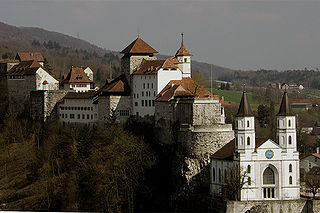
Aarburg Castle is a castle in the municipality of Aarburg in the canton of Aargau in Switzerland. It is located high above the town Aarburg on a steep, rocky hillside. The castle was built around a medieval castle, which controlled the narrow point on the Aare river and served as the seat of Aarburg Vogt. It is classified as a Swiss heritage site of national significance. Today it houses the Kantonale Jugendheim, for holding and rehabilitating juvenile offenders.

The Grünenberg family was a medieval Swiss noble family. The family was active from the middle of the 12th century until the 15th century in the Swiss Plateau, mostly in the Bernese Oberaargau. There were two major branches, the Grimme and Schnabel lines which then further divided into other branches. Some of these branches owned land in Alsace and in southern Bavaria, especially in the Markgräflerland and in Breisgau. About one hundred members of the family are known today. The family name comes from Grünenberg Castle in Melchnau in the Canton of Bern.
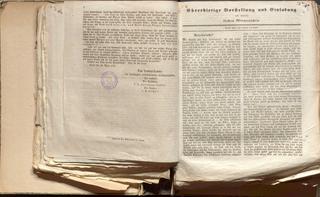
Rudolf Sutermeister was a Swiss medical doctor for the poor. He was also a businessman, a manufacturer, an early socialist and a socio-political writer. He is considered one of the first native Swiss German socialists, together with Gustav Siegfried, Johann Jakob Treichler, and Karl Bürkli; however, unlike Siegfried, he is also considered a utopian.

Elisabeth von Rapperswil was the last countess of the House of Rapperswil, and secured by her second marriage the female line of the Counts of Rapperswil and the extensive possessions of Rapperswil in the former Zürichgau to the Laufenburg line. Her son by first marriage was Reichsvogt Wernher von Homberg, and her oldest son by second marriage was Count Johann von Habsburg-Laufenburg who passed over the title of the count of Rapperswil to his oldest son Johann II and his brothers Rudolf and Gotfried.

Johann I von Habsburg-Laufenburg was the Count of the House Habsburg-Laufenburg and later Count of the House of Rapperswil.
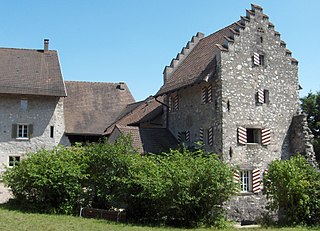
Altenburg Castle is a castle in the village of Altenburg bei Brugg in the municipality of Brugg in the canton of Aargau in Switzerland. The castle and the Altenburg Roman ruins, which are integrated into it, are classified as Swiss heritage site of national significance.

Trostburg Castle is a small castle in the municipality of Teufenthal in the canton of Aargau in Switzerland.
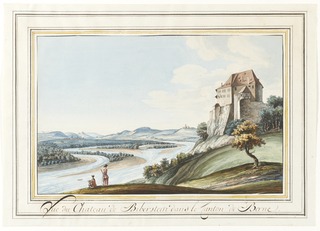
Biberstein Castle is a castle in the municipality of Biberstein in the Swiss canton of Aargau.
Werner Wehrli was a Swiss composer. He was one of the most renowned Swiss composers in the period between the world wars.
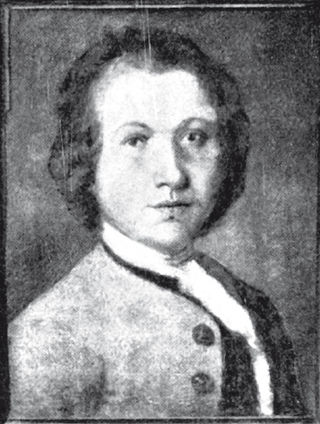
Franz Ludwig Wind was a Swiss sculptor and wood carver.

Michael Traugott Pfeiffer was a Swiss music pedagogue. Together with Hans Georg Nageli, they are considered pioneers of the Swiss choral movement at the beginning of the 19th century.
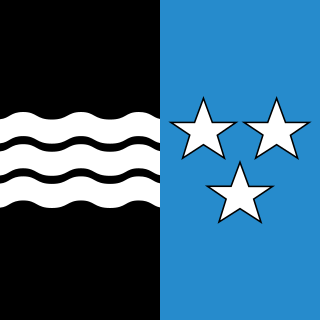
The History of the Canton of Aargau is dedicated to Aargau in Switzerland, founded in 1803, and its various preceding territories.


























